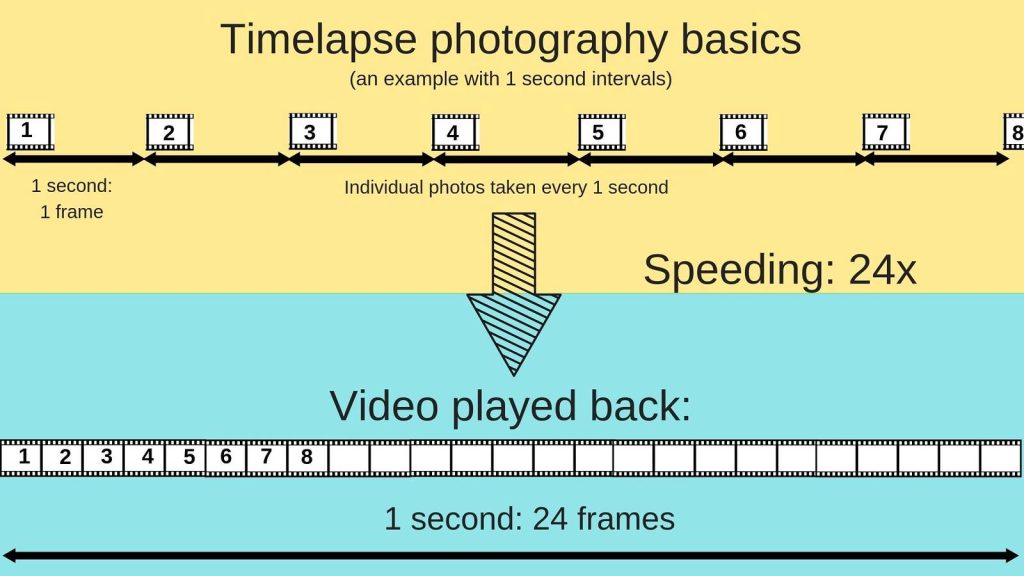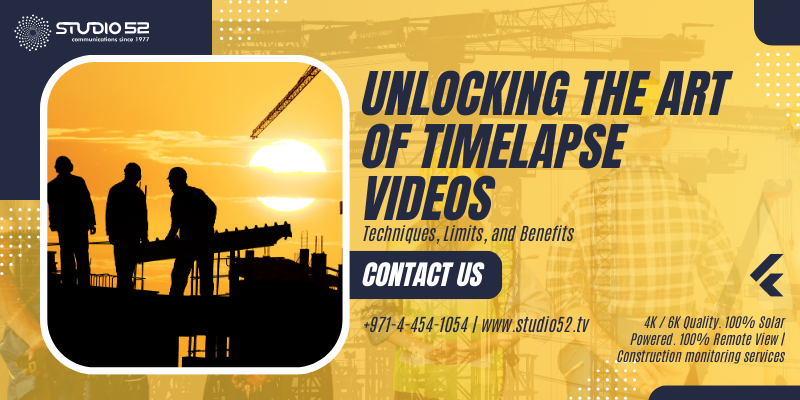Timelapse videos have emerged as one of the most captivating and popular forms of visual storytelling in the digital age. These mesmerizing sequences condense hours, days, or even years of real-time footage into a matter of seconds or minutes. Whether you’re an aspiring filmmaker, a hobbyist, or just someone intrigued by the art of time-lapse, this article will delve deep into the techniques, limits, and benefits of mastering time-lapse videos.
Understanding TimeLapse Basics
Before we embark on our journey into the world of advanced time-lapse techniques, let’s start with the fundamentals of time-lapse photography and videography. At its core, time-lapse involves capturing a series of photos or video frames at set intervals and then playing them back at a standard frame rate. This simple yet powerful concept creates the illusion of time moving quickly, revealing the gradual changes that occur in a scene.

Choosing the Right Equipment
For creating perfect timelapse videos, you need the right equipment. A digital camera with manual settings is essential for full control over your shots. A sturdy tripod is indispensable to ensure your camera remains steady during the entire shoot, preventing shaky footage. Additionally, an intervalometer (or a smartphone app with time-lapse functionality) is essential to automate the process of taking photos at regular intervals.
Investing in high-quality lenses and filters can significantly improve the final result. Wide-angle lenses are great for capturing expansive landscapes, while macro lenses excel at close-up time-lapses. Filters like ND (neutral density) filters can be used to control exposure and create long-exposure effects in daylight scenes.
Expand your knowledge with Hyperlapse Timelapse Difference
Finding the Perfect Subject
Selecting the right subject is paramount to a successful time-lapse project. Natural landscapes, bustling cityscapes, construction sites, starry night skies, and blooming flowers are just a few examples of captivating subjects. The key is to choose a subject that not only aligns with your creative vision but also has the potential for transformation or movement over time.
Consider the story you want to tell through your time-lapse. Is it the birth of a flower, the construction of a skyscraper, or the movement of clouds over a picturesque landscape? The subject should engage your audience and spark their curiosity.

Advanced Techniques for Time-Lapse Mastery
Now that we’ve laid the groundwork, it’s time to explore advanced techniques that can elevate your time-lapse videos to the next level. These techniques will help you create truly mesmerizing and cinematic time-lapse sequences.
Shutter Speed and Interval
Experimentation is key when it comes to shutter speed and interval settings. Shutter speed determines how long each individual frame is exposed, while the interval dictates how often a new frame is captured. Together, they influence the overall look and feel of your time-lapse.
A longer shutter speed, such as several seconds or even minutes, can create smooth and dreamy motion in your time-lapse. This is particularly effective for capturing the movement of clouds or the flow of water. Shorter intervals, on the other hand, result in more rapid changes between frames, suitable for scenes with fast-moving subjects like traffic or people.
The key is to strike a balance that suits your subject and creative vision. Consider creating a test time-lapse with various settings to see what works best before committing to a lengthy shoot.
Motion Control
Introducing motion into your time-lapse sequences can add an extra layer of dynamism and sophistication. Motorized sliders and pan-tilt heads allow for controlled camera movement, resulting in cinematic and dramatic time-lapse shots.
For example, using a motorized slider, you can achieve a smooth and steady lateral motion while capturing a sunrise or sunset. This adds a dynamic element to your time-lapse, making it more visually engaging. Similarly, a pan-tilt head can be used to create sweeping panoramic time-lapse shots.
Day-to-Night Transitions
Capturing the transition from day to night or vice versa is a challenging yet incredibly rewarding technique in time-lapse photography. This technique, often referred to as the “Holy Grail” time-lapse, requires precise exposure and white balance adjustments as light conditions change.
To master this technique, start by setting up your camera for daytime shooting. As the light diminishes and transitions into night, you’ll need to gradually adjust your camera settings to maintain consistent exposure. This can be done manually or with the help of specialized time-lapse software.
Post-Processing Magic
While capturing the images or frames is the first step, the magic of time-lapse often happens in post-processing. Editing software like Adobe Premiere Pro, Final Cut Pro, or dedicated time-lapse editing tools allow you to stitch together your images or frames seamlessly. During this process, you can apply color correction to enhance the overall look, add music or narration to create a compelling narrative, and fine-tune the timing of your time-lapse sequence.
Don’t underestimate the power of post-processing; it can transform a collection of images into a breathtaking time-lapse video.
Limits and Challenges
While time-lapse videos offer incredible creative opportunities, they also come with their own set of limits and challenges that aspiring time-lapse creators should be aware of.
Duration
Creating a time-lapse video requires a considerable amount of patience. Some projects can span hours, days, or even months, depending on your subject. Before embarking on a time-lapse journey, ensure you have the time and resources to complete your vision. Long-term projects can be especially challenging to maintain, as they may require constant monitoring and camera adjustments.
Weather and Environmental Factors
Weather conditions can be unpredictable and significantly affect your shooting schedule. Rain, wind, or extreme temperatures may pose challenges when capturing your chosen subject. Adequate protection for your camera and equipment is crucial to ensure they remain functional in adverse conditions.
Equipment Limitations
Not all equipment is suitable for every time-lapse project. High-resolution time-lapses, especially those intended for large screens or theaters, demand more storage and processing power. Be prepared to invest in the necessary gear and software to handle the demands of your project. Additionally, keep in mind that equipment maintenance is essential to prevent technical issues that could disrupt your shoot.
Studio 52: Your Partner in Time-Lapse Excellence
For those looking to embark on their time-lapse journey with confidence, Studio 52 is a company that stands as a beacon of expertise and innovation. Studio 52 specializes in time-lapse video production, offering a wide range of services to help you bring your vision to life.
With a team of experienced professionals and cutting-edge equipment, Studio 52 can handle projects of all sizes and complexities. Whether you’re documenting a construction project, capturing the beauty of nature, or telling a unique visual story, Studio 52’s expertise will ensure that your time-lapse project exceeds expectations.
From planning and shooting to post-production and final delivery, Studio 52 provides end-to-end solutions tailored to your specific needs. They understand the intricacies of time-lapse photography and videography, including the challenges of long-term projects and the importance of precise editing.
Capture Every Moment with Precision! 📸 Hire Us Today for Expert Timelapse Camera Services
The Benefits of Time-Lapse Mastery
Now that we’ve explored the techniques, limits, and challenges of time-lapse, let’s delve into the numerous benefits that come with mastering this captivating art form.
- Captivating Storytelling: Time-lapse videos have the unique ability to condense long and often slow processes into visually compelling stories. They engage viewers by offering a fresh perspective on familiar scenes and subjects. Whether it’s showcasing the growth of a plant, the bustling activity of a city, or the transformation of a construction site, time-lapses can communicate a narrative in a way that standard video or photography cannot.
- Versatility: Time-lapse videos find applications in various fields, making them a versatile tool for creators and professionals alike. Filmmakers use time-lapse to depict the passage of time within their narratives, adding depth and emotion to their storytelling. Documentary producers employ time-lapses to illustrate environmental changes and historical events. In marketing, timelapses can be used to highlight product development or demonstrate the benefits of a service. Even educators leverage timelapses to explain complex processes in an engaging and accessible manner.
- Increased Visibility: In the digital era, captivating visuals are key to capturing an audience’s attention. Sharing your unique time-lapse creations on platforms like YouTube, Instagram, TikTok, and Vimeo can significantly boost your online presence. Timelapses often garner more views and shares than traditional videos or static images due to their inherent visual appeal. This increased visibility can be valuable for artists, businesses, and content creators looking to stand out in a crowded digital landscape.
- Personal Satisfaction: The satisfaction of bringing a time-lapse project to life is incomparable. Watching your vision unfold in fast motion, from the initial concept to the final edit, is a rewarding experience that fuels creativity. It’s a testament to your dedication and skills as a visual storyteller. The sense of accomplishment that comes with mastering time-lapse photography and videography can be a powerful motivator to continue exploring and pushing your creative boundaries.
Conclusion:
Mastering timelapse video production is a creative journey filled with endless possibilities. From capturing the passage of time in stunning landscapes to sharing the evolution of construction projects, time-lapse is a versatile and captivating art form that continues to evolve with technology. Embrace the techniques, overcome the limits, and reap the benefits of this mesmerizing storytelling medium. Start your time-lapse adventure today and watch your creativity bloom in fast-forward. Studio 52 is here to support and elevate your time-lapse endeavors to new heights of excellence.
FAQ
Q: What is time-lapse photography?
A: Time-lapse photography is a technique used to create videos or images that show change over time. It involves taking a series of photos or video frames at set intervals and then playing them back at a standard frame rate. This creates the illusion of time moving quickly, revealing the gradual changes that occur in a scene.
Q: What equipment do I need for time-lapse photography?
A: To create stunning time-lapse videos, you need a digital camera with manual settings, a sturdy tripod, and an intervalometer (or a smartphone app with time-lapse functionality). Investing in high-quality lenses and filters can also significantly improve the final result.
Q: How do I choose the right subject for time-lapse photography?
A: When choosing a subject for time-lapse photography, it is important to select something that has the potential for transformation or movement over time. Natural landscapes, bustling cityscapes, construction sites, starry night skies, and blooming flowers are just a few examples of captivating subjects.
Q: What are the limits and challenges of time-lapse photography?
A: Time-consuming and weather-dependent, requiring high-performance equipment.
Q: What are some advanced time-lapse techniques?
A: Some advanced time-lapse techniques include:
Motion control: Using motorized sliders and pan-tilt heads allows for controlled camera movement, resulting in cinematic and dramatic time-lapse shots.
Day-to-night transitions: Capturing the transition from day to night or vice versa is a challenging yet incredibly rewarding technique in time-lapse photography. It requires precise exposure and white balance adjustments as light conditions change.


